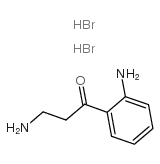304-47-2
| Name | Kynuramine dihydrobromide |
|---|---|
| Synonyms |
3-(2-Aminophenyl)-3-oxopropanamine
3-amino-1-(2-aminophenyl)propan-1-one,hydrobromide |
| Description | Kynuramine (dihydrobromide), an endogenously occurring amine, is a fluorescent substrate and probe of plasma amine oxidase[1][2]. |
|---|---|
| Related Catalog | |
| In Vitro | Kynuramine (dihydrobromide) 在体外抑制突触前和突触后 α-肾上腺素受体[2]。 Kynuramine 已被证明是狗脑动脉血清素受体的部分激动剂[2]。 Kynuramine (20 μg/mL) 经常导致回肠轻微收缩,但未能改变胆碱能刺激的抽搐反应[2]。 |
| In Vivo | Kynuramine (dihydrobromide) (0.064、0.32、1.6 或 8 μg;脑室内;单剂量) 促进雌激素激发的去卵巢大鼠前凸行为[3]。 Kynuramine (1.25、2.5 和 5.0 mg/kg;静脉注射;单剂量) 可增加大鼠的心率和血压[4]。 Animal Model: Female rats[3]. Dosage: 0.064-8 μg. Administration: Intraventricular injection; single does. Result: Produced facilitation of lordosis behavior. Animal Model: Male rats (about 200g)[4]. Dosage: 1.25-5.0 mg/kg. Administration: Intravenous injection; single does. Result: Promoted heart rate and blood pressure. |
| References |
| Boiling Point | 367.3ºC at 760mmHg |
|---|---|
| Molecular Formula | C9H14Br2N2O |
| Molecular Weight | 326.02800 |
| Flash Point | 175.9ºC |
| Exact Mass | 323.94700 |
| PSA | 69.11000 |
| LogP | 3.99800 |
| Storage condition | 20°C |
| Personal Protective Equipment | Eyeshields;Gloves;type N95 (US);type P1 (EN143) respirator filter |
|---|---|
| RIDADR | NONH for all modes of transport |
| WGK Germany | 3 |
